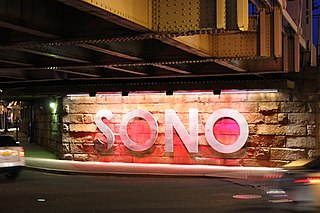
Norwalk is a city in and the county seat of Huron County, Ohio, United States. The population was 17,012 at the 2010 census. The city is the center of the Norwalk Micropolitan Statistical Area and part of the Cleveland-Akron-Canton Combined Statistical Area. Norwalk is located approximately 10 miles (16 km) south of Lake Erie, 51 miles (82 km) west/southwest of Cleveland, 59 miles (95 km) southeast of Toledo, and 87 miles (140 km) north/northeast of Columbus.

Rye is a town in Westchester County, New York, United States. The population was 45,928 at the 2010 census. It is a separate municipality from the city of Rye. The town of Rye contains two villages – Port Chester and Rye Brook – along with a portion of the Rye Neck section of the village of Mamaroneck. These villages comprise the entire area of the town of Rye.

South Norwalk is a neighborhood and the Second Taxing District in Norwalk, Connecticut. The neighborhood was originally a settlement called 'Old Well' which became chartered as the city of 'South Norwalk' on August 18, 1870. The cities of Norwalk and South Norwalk were incorporated on June 6, 1913. The neighborhood is often referred to with the acronym 'SoNo'.

The history of Norwalk, Connecticut ranges from pre-contact cultures and Native Americans to the 21st century.
The Norwalk Hour is a daily newspaper published in Norwalk, Connecticut, by Hearst Media Services, Connecticut. It primarily covers and serves the city of Norwalk.

The Norwalk rail accident occurred on May 6, 1853, in Norwalk, Connecticut, and was the first major U.S. railroad bridge disaster; 48 were killed when a train travelling at 50 mph plunged into the Norwalk Harbor off of an open draw (swing) bridge.

James William Hyatt was Treasurer of the United States from 1887 to 1889. He had previously served as Bank Commissioner for the State of Connecticut, and United States Bank Examiner for Connecticut and Rhode Island. He served as a Democratic member of the Connecticut House of Representatives in 1875 and 1876, a member of the Connecticut Senate in 1884, and he was Warden of the Borough of Norwalk from 1877 to 1878, from 1880 to 1882, and from 1885 to 1887.
Bob Duff is a five-term Democratic member of the Connecticut Senate, representing Norwalk and part of Darien, Connecticut in Connecticut's 25th District since 2001. He previously served as a member of the Connecticut House of Representatives, representing the 137th District. He is currently Majority Leader of the Connecticut Senate, and serves as chair of the Executive and Legislative Nominations Committee and vice chair of the Legislative Management Committee.
Jesse Milton Coburn (1853–1923) was a one-term Republican mayor of South Norwalk, Connecticut, from 1897 to 1898.
Charles Alfred Scofield (1853–1910) was a one term Democratic mayor of Norwalk, Connecticut from 1907 to 1908. He defeated Democrat Ferdinand B. Smith for the office in 1907. He had previously served on the Norwalk City Council.

Peter L. Cunningham was a one-term mayor of South Norwalk, Connecticut in 1883.
Asa Burr Woodward was a member of the Connecticut Senate representing the 12th District from 1871 to 1873, a member of the Connecticut House of Representatives representing Norwalk from 1867 to 1869, and a Warden of the Borough of Norwalk in 1872.
Stiles Curtis was a Warden of the Borough of Norwalk, Connecticut from 1845 to 1853.
Samuel Lynes was Warden of the Borough of Norwalk, Connecticut from 1853 to 1855, from 1859 to 1860, and from 1871 to 1872.
Asa Smith was Warden of the Borough of Norwalk, Connecticut from 1863 to 1865, from 1870 to 1871 and from 1873 to 1874. He also was a member of the Connecticut House of Representatives representing Norwalk from 1869 to 1870, and was a member of the Connecticut Senate representing the 13th District from 1885 to 1886.
Samuel Hale was a founding settler of Hartford and Norwalk, Connecticut. He was a deputy of the General Court of the Colony of Connecticut from Norwalk in the sessions of 1656, 1657 and 1660.
Walter Hoyt was a founding settler of Norwalk, Connecticut. He served as a deputy of the General Court of the Connecticut Colony from Norwalk between 1658 and 1662, and, when it was renamed, as a deputy of the Connecticut General Assembly between 1662 and 1681. He was a Norwalk selectman in 1672.
Thomas Hanford was a founding settler of Norwalk, Connecticut. He was the first minister in Norwalk, and continued in charge of the settlement's church for forty-one years, until his death in 1693. In addition to his spiritual leadership, he also served as the civic leader and school teacher of the settlement.
Matthew Marvin Jr. was a founding settler of Norwalk, Connecticut. He served as a deputy of the General Assembly of the Colony of Connecticut from Norwalk in the sessions of May 1694, and May and October 1697.








